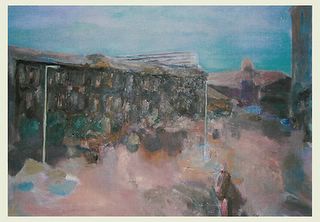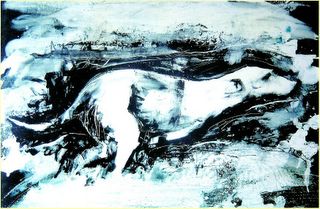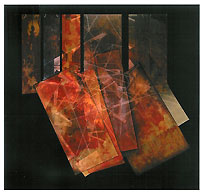Claire Whitten
F a c e t o F a c e w i t h C l a i r e W h i t t e n
Fitzwilliam Street, oil on canvas
If one word could sum up what Claire's Whitten's paintings are all about, I would choose 'mystery'. In her earlier work she was drawn towards the mystery of cathedrals, investigating and exploring the architectural shapes and spaces. Lately she has been painting mysterious cityscapes of a Belfast in the aftermath of 'The Troubles', 'a place in transition...in twilight, portraying images of empty streets and wide-open areas waiting to be filled with new enterprise'. There's another mystery evident; the fact that her earlier paintings seem to radically differ in style from her latest paintings, is just a small detail.
"It's just the subject matter that's changed," she says.
I find that statement intriguing, since she's obviously seeing something the rest of us dont. Standing in the gallery, the paintings numbered 1-8 are vividly coloured, abstract and full of opposing forces. Turn forward to take in paintings 9-11, and the colours are growing more subdued, and the spaces inside the canvass less crowded. To one's right comes the real surprise: 'spectral imagery' steeped in low light. Yet, the more time one spends in Claire Whitten and her paintings' company, the more things come together.
I met the artist at the talk she gave in the Portadown Millenium Court Arts Centre, where she is currently exhibiting. She is unpretentious, fresh and easy to talk to. The words she used to describe her painting, were 'instinctive', 'explorative' and 'experimental'. Her earlier work was all done from the imagination, her latest works - 'Fitzwilliam Street', 'Castle Street' and 'Ormeau Avenue' were done from snapshots and drawings, thus more figurative.
A visitor to the artist's talk observed that it was possible to zoom in on a section of one of Claire's later paintings, and arrive at a point where it would be very similar to her earlier abstract works. It does seem as if she has moved back from her subject, and painted with a clearer perspective, leaving the observer with a sense of her greater confidence in painting. The fact that all the later paintings are framed, whereas most of the earlier ones are not, seems to suggest that the later ones are more resolved. As the leaflet accompanying the exhibition states:
'The paintings not only demonstrate skill and aesthetic awareness but the content and theme of work equally as compelling... Whitten uses moody colours and tones creating a set of extraordinary and haunting pieces of artwork that both intrigue and mystify the viewer.'
It would be interesting to see if Whitten could maintain the intensity of her earlier painting, her sense of exploration and dealing with conflicting issues - and integrate that with her new innovations.

